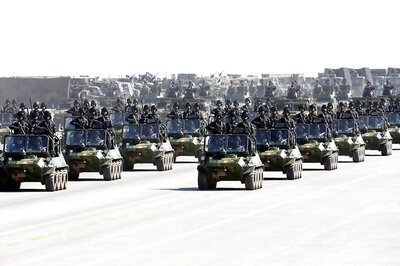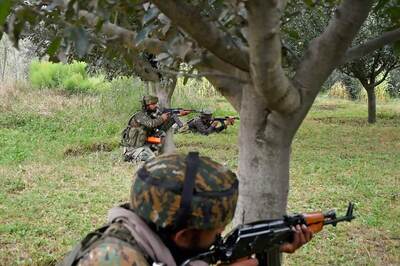
views
Bengaluru: As hearts almost stopped, scientists at the Indian Space Research Organisation (ISRO) successfully placed Chandrayaan-2, the country’s second lunar mission, into its orbit around the Moon.
The lunar orbit insertion (LOI) manoeuvre was fired between 8.34am and 9.02am on Tuesday, ending a 28-minute firing of the engines to put the lunarcraft into its destined orbit. Now that the lunarcraft is going around the Moon, it will next be eased into a different, lowered orbit over the next 10 days, before a ‘soft-landing’ on it is attempted on September 7.
“No other mission has landed on the South Pole. They have all landed nearer the Equator of the Moon. But the unique requirement for a landing at the South Pole is that we need to achieve an orbit with an inclination of 90 degrees,” said ISRO chairman K Sivan at a media briefing after the LOI.
The smallest deviation of even 10cm will change the inclination of the orbit by 7 degrees and this will end up affecting the mission. That is the kind of precision needed for this mission from here on, till September 7.
Challenges of Keeping Mission in Its Place
The mission must remain in the exact place that ISRO wants it to be — at the exact velocity, reducing speed at the exact pace needed, the exact distance in its orbit from the Moon and exact inclination to the Moon. There will be four more lunar burns — the first one by Wednesday, the next three on August 28, 30 and September 1.
“The next major event is on September 2 when we will look at separating the lander from the orbiter. Till now, all the operations are carried out by the propulsion system of the orbiter. From September, it will be carried out entirely on the lander. On September 7, we will start a powered descent on the lander to the Moon’s surface at 1.40am,” said the chairman.
This, he had earlier said, would be the most terrifying 15 minutes in the mission — as the manoeuvre depends on the on-board systems that are autonomously built — it won’t be controlled from the ground station here in Bengaluru.
By then, the lunarcraft will be so close that it could even be grazing the mountain-tops on the Moon. However, it will be hovering over the surface to find the right designated spot between two craters. It will hover over the surface to take pictures and decide on its own if its path is right, while moving itself to the spot.
The spot chosen has a slope of less than 12 degrees, because any slope over this could topple the lunarcraft, as will the presence of many boulders. Secondly, the four thrusters on the lander that will propel it towards the right spot will also be switched off just before it approaches the Moon’s surface, as its operation could end up with moon-dust rising, thus, affecting the mission itself.
What Happens on Sept 7
“Two hours after landing, the rover will touch the ground and an hour after that, the solar panel will be deployed and it will slowly start moving. We are sure of landing at 1.55am on September 7, and five and half hours after the landing, the first pictures or data will be sent back,” Dr Sivan said.
The mission seeks to find out more about this hitherto unexplored territory of the Moon — its chemical and mineral components, the presence of water, sub-surface temperatures, seismic activity along the surface — all of which will go into providing critical inputs for future missions to the Moon.
It is of international interest as Nasa has announced plans for a human habitat near the South Pole and data from Chandrayaan-2 will help devise such a habitat. That’s one of the reasons this mission has attracted worldwide attention. The rover is designed to go around the lunar surface at 1cm per second and will move at best 500m in its entire mission life-span.
“For 30 minutes, our hearts almost stopped while carrying out today’s manoeuvre (LOI). All of our eyes were glued to the control systems, checking on the health of the systems… We were so anxious... And, we are more terrified now (about the 15-minute landing manoeuvre)… Once powered descent starts, we have no control over it,” Sivan said, adding, “We have done all the simulation possible, for systems and sub-systems, done whatever is humanly possible.”
He also said that ISRO has learnt from past mistakes — not just in Chandrayaan-1, but from missions of other countries. For instance, from Israel’s mission, ISRO’s takeaway was to ensure sensor calibration and making the systems more autonomous to function independently, as the lander will be doing now.
A Life Beyond 14 days?
The mission’s lifespan is just one lunar day, that is, 14 earth days, from September 7 to September 21. After that, when it is night on the Moon, the lander will not be able to get solar power to keep its batteries charged up.
However, after a lapse of another 14 days, beyond the first week of October, if the sensors and other systems are not affected by the extreme temperatures, ISRO could potentially look at re-charging its batteries from solar power when it is day yet again on the moon.
“We have qualified it (the lander and rover) for that kind of temperature, but cannot say with confidence it will happen. It may happen if lucky,” he said.




















Comments
0 comment